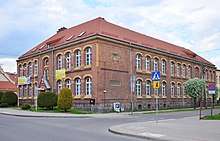Nowe Miasto Lubawskie
Nowe Miasto Lubawskie [ˈnɔvɛ ˈmʲastɔ luˈbafskʲɛ] (German: ![]()
Nowe Miasto Lubawskie | |
|---|---|
   
| |
 Flag  Coat of arms | |
 Nowe Miasto Lubawskie  Nowe Miasto Lubawskie | |
| Coordinates: 53°25′32″N 19°35′16″E | |
| Country | |
| Voivodeship | |
| County | Nowe Miasto |
| Gmina | Nowe Miasto Lubawskie (urban gmina) |
| Established | 1325 |
| Town rights | 1325 |
| Government | |
| • Mayor | Józef Blank |
| Area | |
| • Total | 11.37 km2 (4.39 sq mi) |
| Elevation | 82 m (269 ft) |
| Population (2016) | |
| • Total | 11,062 |
| • Density | 970/km2 (2,500/sq mi) |
| Time zone | UTC+1 (CET) |
| • Summer (DST) | UTC+2 (CEST) |
| Postal code | 13-300 |
| Area code(s) | +48 56 |
| Car plates | NNM |
| Website | www.umnowemiasto.pl |
Geographical location
Nowe Miasto Lubawskie lies on the right (west) bank of the upper course of the River Drwęca in Gdańsk Pomerania, some 15 km south-west of the town of Lubawa, 70 km south-west of the town of Olsztyn, and 120 km south-east of the region's capital, Gdańsk.
History
Early history involved settlement by early Slavic peoples; later settlement was by Old Prussians who were conquered by Polish ruler Bolesław Krzywousty.[1] In 1310 the Teutonic Order acquired the region of Gdańsk Pomerania and Otto von Luttenberg, Komtur of Culm, founded the settlement in 1325. It was known under the names Nuwenmarkt, Novum Forum and Nowy Targ.[1] Between 1334–43 it was the seat of a Vogt of the Teutonic Order. It adopted Kulm law in 1353.
In Polish–Teutonic War of 1410 the town briefly became part of Poland due to result of local fighting, and remained so until the 1411 Peace Treaty. In 1454, the city joined the Prussian Confederation, an association of cities and gentry that opposed the policies of the Order and wanted the region to become part of Poland.
After the Second Peace of Thorn (1466) the town was reincorporated into the Kingdom of Poland, where it remained until 1772. Administratively, it was part of the Chełmno Voivodeship in the province of Royal Prussia (which after 1569 was itself part of the province of Greater Poland). During the Reformation, in 1581 the parish church, which is almost as old as the town itself, became evangelical. In the 18th century the town was still surrounded by a town wall and by a rampart, and the parish church was Catholic.[2] A Protestant church was built in 1824.
In the First Partition of Poland in 1772 Gdańsk Pomerania was incorporated into the Kingdom of Prussia, and Neumark belonged now to the newly formed province of West Prussia. It was briefly regained by the Poles and was part of the short-lived Polish Duchy of Warsaw between 1807 and 1815, and later it, again, fell under Prussian rule. At the end of the 19th century, the town was capital of Landkreis Löbau in the Prussian administrative district of Regierungsbezirk Marienwerder in West Prussia, where it remained until 1919. It had a Lutheran and a Catholic church, a Progymnasium, a court, a steam mill with grain trading, and (as of 1885) 2,678 inhabitants. The monastery Maria-Lonk was nearby. Around 1908 the town also had a dairy, an electric power plant, three sawmills and brickwork.[3]
When after World War I the Treaty of Versailles became effective in January 1920, and the Polish Corridor was created, the town was incorporated into the Second Polish Republic, close to the border with German East Prussia. During the Second Polish Republic, Nowe Miasto Lubawskie was the capital of Nowe Miasto County (Polish: powiat nowomiejski) in the Polish Pomeranian Voivodeship.

On 3 September 1939, during the German Invasion of Poland, the town and the local area were occupied. Afterwards 2,500 civilians were murdered in actions carried out by the SS and units made up from German minority's militia, the Selbstschutz.[1] From 26 October 1939 to 1945 Neumark belonged to Landkreis Löbau/Neumark in the province of Reichsgau Danzig-West Prussia.
On 21 January 1945 the town was captured by the Red Army. After the war the town returned to Poland which by then had become the People's Republic of Poland.

.jpg)
Famous people
- Katarzyna Dąbrowska, Polish actress
- Zyta Gilowska, Polish economist and politician
- Wiesław Lendzion, Polish footballer
- Joseph Newmark (1799–1881), American Orthodox rabbi
- Philip Newmark, father of Harris Newmark, Los Angeles pioneer and retailer
- Harry von Posadowsky-Wehner (1869–1923), German military person
- Jonatan Straus, Polish footballer
- Nikolaus von Vormann, German military person, Wehrmacht general
- Leszek Werner (1937–2014), Polish organist and music educator
International relations
Twin towns — Sister cities
Nowe Miasto Lubawskie is twinned with:


References
- "O Mieście Urząd Nowego Miasta Lubawskiego". umnowemiasto.pl. Archived from the original on 2012-02-04.
- Goldbeck, Johann Friedrich (1789). Vollständige Topographie des Königreichs Preußen, Part II. Marienwerder. pp. 45–46.
- Meyers Großes Konversations-Lexikon. 14 (6th ed.). Leipzig and Vienna. 1908. p. 565–566.
- Rademacher, Michael (2006). "Provinz Westpreußen, Kreis Löbau/Neumark" [German administrative history of the province of West Prussia, district of Löbau/Neumark]. Deutsche Verwaltungsgeschichte (in German). Archived from the original on 2013-07-12.
- Preuß, August Eduard (1835). Preußische Landes- und Volkskunde. Königsberg. p. 436.
External links
| Wikimedia Commons has media related to Nowe Miasto Lubawskie. |
- (in Polish) Tygodnik Internetowy - weekly alternative newspaper online features top news stories, local information for Nowe Miasto area.
- (in Polish) Official town website
- Old photo of towns square and church
- Images of Nowe Miasto Lubawskie
- Liek, Gustav (1893). Die Stadt Löbau in Westpreussen mit Berücksichtigung des Landes Löbau ("The city of Löbau/Lubawa, West Prussia with consideration for Löbau District", downloadable PDF) (in German). Historischer Verein für den Regierungsbezirk Marienwerder.

